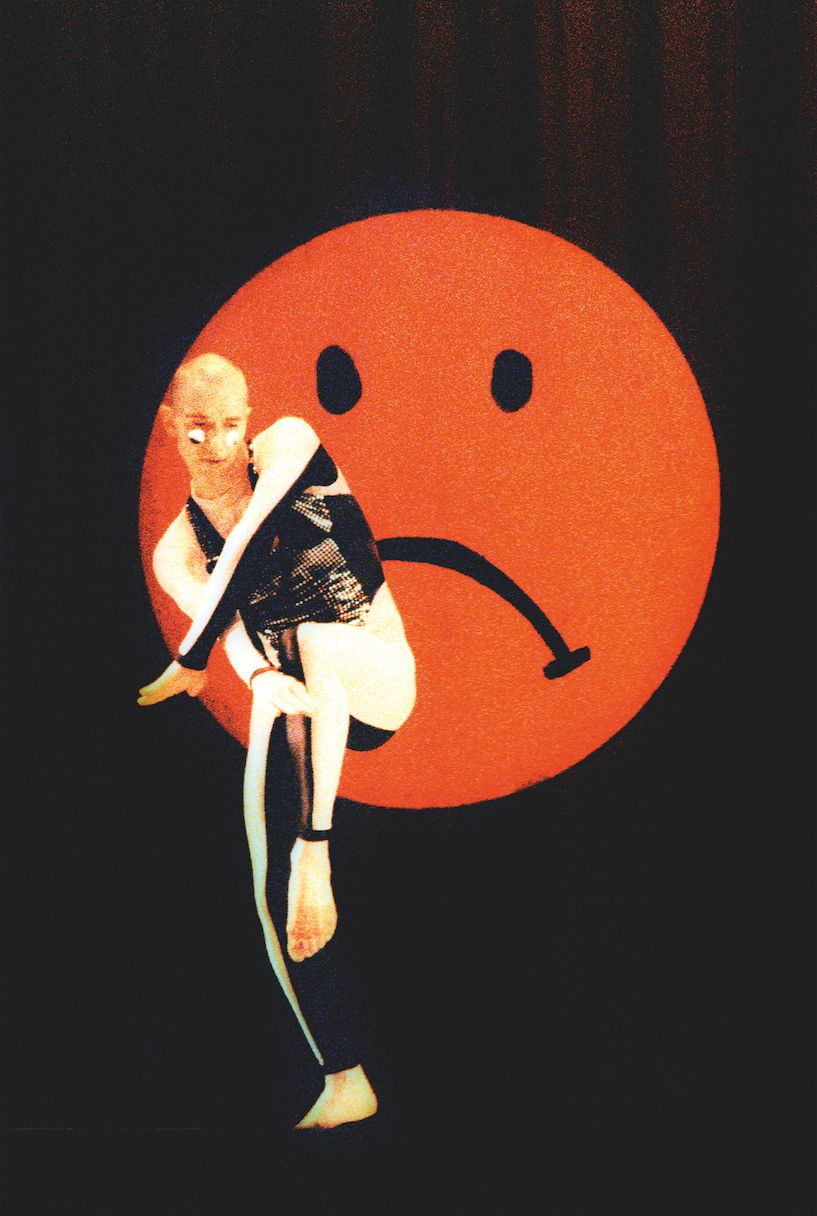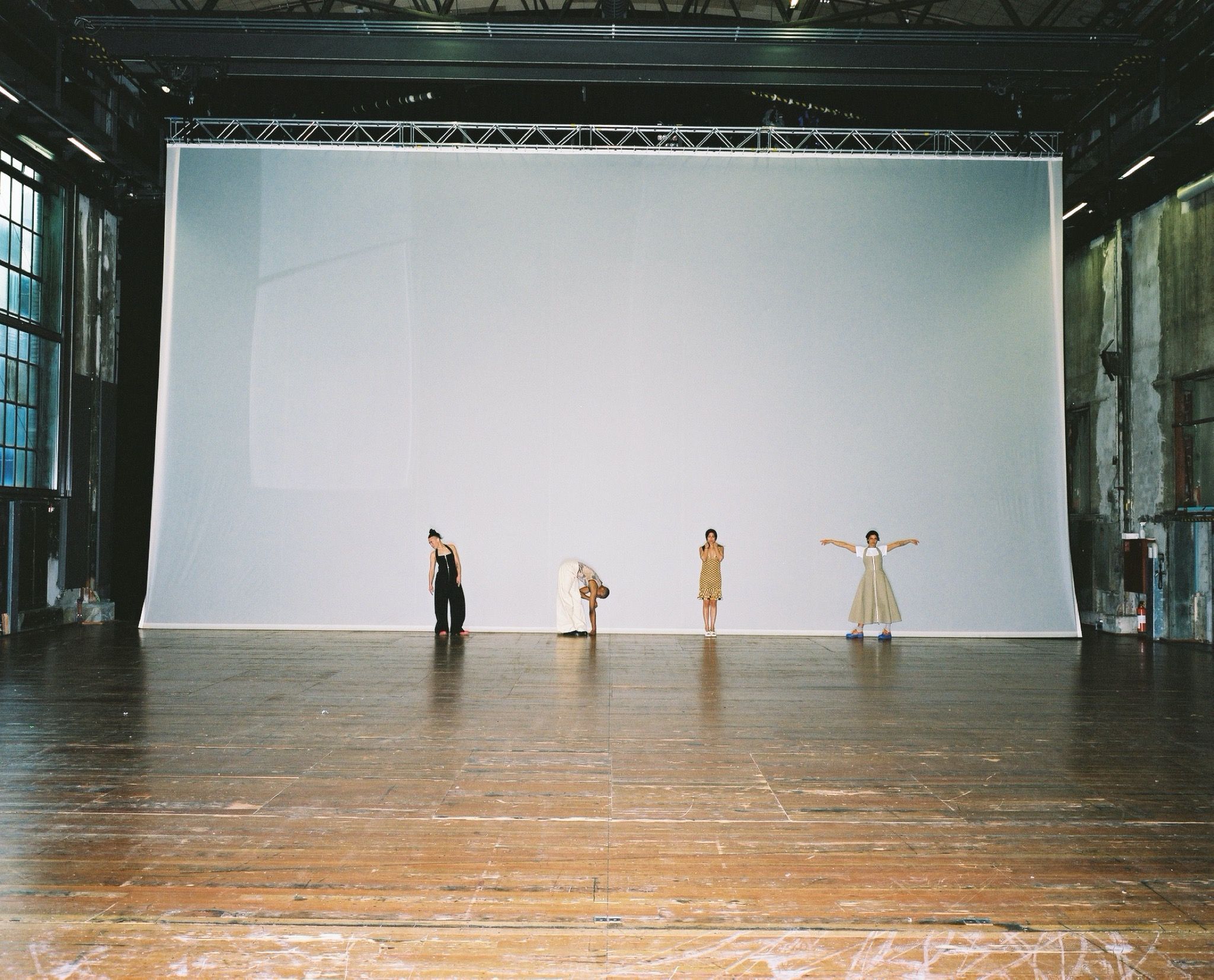“Its Sound and Shape in my Mouth:” EDDIE PEAKE and the Enjoyment of Sexual Ambiguity
Google Eddie Peake and you will be confronted with images of sculpted nudity, lacquered spray paintings, and gritty music videos. His recent exhibition “The Forever Loop” at the Barbican in London successfully marked the first decade of Peake’s career as an artist. The show, a three-month, ten-hour-a-day installation, explored sexual identity, desire, and its origins. Peake welcomed visitors with a series of looped choreographies, performed by naked dancers, and roller skaters in sheer onesies gracefully gliding through the space. Tommaso Speretta spoke with Peake about his work and the undeniable importance of eroticism.

Every interview-based text I’ve read about you surprisingly points out that you are not the “naughty child” that your art makes you out to be, but that instead you are a “gentle presence” who grew up in an artsy family from North London and received his education from the best art schools in the country.
Yes, it’s annoying.
You are also often referred to as one of the most interesting emerging talents. How do you feel about that?
I’m really glad people are interested, so I’m happy about that aspect of it. Some of the labels, like “young,” “cool,” “enfant terrible,” can be annoying, as well as lazy and clichéd on the part of the people writing that stuff. Now that I’ve done the Barbican show though, which sort of wraps up the first ten years that I’ve been exhibiting, as well as showed people that I’m an absolute baller, things will hopefully settle on that front. Or they won’t. Either way, I am very lucky that people are interested in what I’m doing.
The show you’re referring to at the Barbican, “The Forever Loop,” was visually very powerful. It was like a mix of all the main elements that characterize your art.
I wanted the show to be a spectacle. One that would confront, as well as entirely engulf the viewer. I wanted it to include a multifarious array of different and sometimes even contrasting elements, so that there would always be a bit more going on than the viewer could fully take in. Kind of like a complete eradication of a passive type of immersive experience. I wanted the show to be an emotional and psychological fiction, based on real experiences and I wanted the fiction to be entertaining. The whole show is constructed around the phenomenon of “the loop.”

How did you come up with this idea of the loop?
My fascination for the loop format actually started many years ago. I was experiencing this frustration with the likely probability of entering a looped artwork anywhere other than the beginning.
What’s the relationship between the different mediums you use in your work?
Gosh, I am asked this so often that by now I really ought to have a rehearsed response. I suppose it varies from one instance to the next. At the moment I think that the singular discipline I work in is “Exhibitions.” I tend to conceive exhibitions as artworks in and of themselves, as total experiences, and I think the exhibitions I make provide a cohesive link between the disparate and fragmented things they include. So yeah, within the context of my shows, I think the connection between things makes sense.
Collaborations have been another key element in your artistic practice, ever since your involvement with the Auto Italia South East collective.
Collaboration was important to my work long before my involvement with Auto Italia. The term “collaboration” is thrown around with abandon at the moment. I’ve collaborated on so many occasions, and with so many different people and practitioners, that I’ve become quite particular about what I think it means and the different forms it can take.
Yeah, people are very vocal about their “collaborating.” The term is becoming kind of overused.
I think the best kinds of collaborations are the ones in which the resulting work is not simply a gluing-together of isolated practices, as is disappointingly very often the case when artists collaborate, but rather something that looks like it was made by one brain. I feel that some instances of working with other people, even in a creative capacity, don’t necessarily need to be called collaborations. For instance, on numerous occasions I’ve been involved in other people’s work in which I’ve given myself entirely to the project. Like, totally subjugated myself to their creative impulses, happily so, and I enjoy the fact that it is their work. With my own performances, the process of making the work is a collaborative one in which I have the great privilege of working with extraordinary dancers, musicians and actors, but I don’t see the resulting work as a collaboration.

Last November you restaged one of your most well known performances, “Touch,” at the Palais de Tokyo in Paris under the title: “DURO.” How did the decision to resurface an old performance arise?
For a long time after I made “Touch,” I felt compelled not to return to it in any way, for a variety of reasons. One reason was that it was part of a mode of performance-making that I wanted to move away from. Namely of setting up a group of conditions, instructions, and parameters and just seeing what happens within them. Another reason was that “Touch” lent itself far too readily to being co-opted by a kind of facile echelon of the media for my liking. But by the time the Palais de Tokyo invitation came along, I had come to terms with the media response to the piece and I also thought that because it was a different country to where “Touch” was originally performed, the new context meant that the work could be seen with fresh eyes. Many more people know about “Touch” than have actually seen it, which is an interesting phenomenon that relates to performance in general. I thought it would be good to give it another outing.
Was it well received by the French audience?
From my point of view, the people who were actually present seemed to really enjoy the piece, and the media response seemed effusive as well. What was kind of unexpected was that numerous people seemed to appreciate me presenting the work specifically with the November terrorist attacks in mind. They seemed to feel it symbolized something defiant and positive in the wake of such tragedy, which I was happy about.

What do you generally expect the audience to project into your art?
First and foremost, I want the work to be enjoyed. That’s a very difficult thing to ask a well-versed art audience to do, as it requires a certain surrendering of one’s critical faculties, at least temporarily. Most art audiences are unprepared to do that. I hope that there is a slower way in which the work might stay with the viewer after they experience it, and that the imagery, themes, ideas and so on will come to them in a more contemplative and critical way.
“DURO” literally means “hard on.” Why did you choose this title?
I always liked the Italian word “duro” in terms of just saying it. Its sound and shape in my mouth. I like that it is an Italian word being used as the title for a performance being presented in France by an English artist. There is no sense in it.
You must be sick of this question, but it’s such an obviously important element to your work, so I have to ask. Why are the erotic dimensions of the body, in combination with the idea of desire, attraction, ambiguity, sex and sexuality, so obsessively central in your work?
It isn’t really a calculated strategy in my approach to making, but rather a simple impulse that I am very often drawn to. I don’t try to make the work erotic, nor to imbue it with an ambiguous kind of sexuality. Instead, I want to make work according to my real-life impulses and feelings. As it so happens, that results in an erotic and ambiguous kind of sexuality, which is how I see my own sexuality. Desire and attraction, as well as other complicated emotions and psychologies implicit in the way that people interact, are thematic phenomena I try to build into the work.
Aren’t you afraid that it might be misread as simply spectacular?
No, I’m not afraid of that. In fact, I like the spectacular. It’s what I want my work to be, and I don’t think that that compromises its criticality, if that’s what you’re implying.

This might also be the case with your website, which consists of a single image of your own erection. That’s it. Why did you made the decision to rely the entire content of your website, and the way you represent yourself, in that single strongly signifying image?
I don’t believe that that single image represents the entirety of what I do, but I very much like the fantasy that it does. I believe individual images can possess great power, even in an age in which that seems to be less and less the case. I like committing to a single image. The way most of us encounter imagery at the moment is as a kind of pluralistic tsunami. Plus, the use of a single image on a website implicates the site as an artwork rather than an archive of artworks.
Do you think that an image can be gay or straight, female or male?
No, I don’t, but I find it totally fascinating that a kind of cultural semiotic understanding of people, places, and things can be so firmly ingrained that we allow ourselves to believe that they can be. I mean, I’m not so much of an insensitive asshole that I think certain things don’t blatantly belong to one demographic or another, but it has to be a pretty extreme instance for it to truly be the case.

You recently realized an installation for the Victoria Beckham store on Dover Street in London. It’s called “Courgettes” and the work consists of a long sentence, which reads “Many courgettes, an equal number of pellicles and very many fingers attached to fraught bodies and minds in tumult.” Again, I can see a certain erotic allusion coming out from this sentence, or am I mistaken?
The sentence describes the occasion of my secondary school class being taught how to use condoms. Every kid was given a condom and a courgette. It was quite a tense moment, though maybe it was just me. Everyone was trying to act unfazed, making puerile jokes, trying to imply they already knew what they were doing. I quite liked the challenge of describing an intensely sexual experience, one that incidentally didn’t even involve any form of actual sex, in a setting in which that kind of subject matter could not be transparently conveyed.

What do you find erotic?
I suppose it ranges from a very conventional set of things, – like tits and ass and multiple big dicks going into vaginas, athletic bodies and beautiful faces, bodies being passed around for penetration by bodies of various sexes – to a very personal set of things. i think that is the point really, that there isn’t a prescriptive idea that I want to put across. I’m not really that interested in the question as a calculated or definitive code that I want to imbue my work with. I work fairly intuitively and see how things develop. I do want it to be sexy though, but maybe that’s a different thing.

